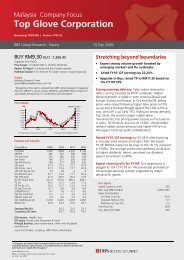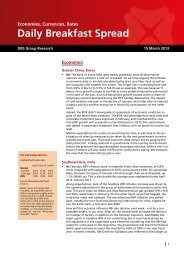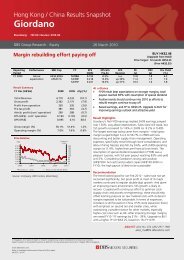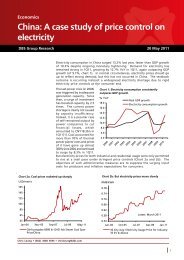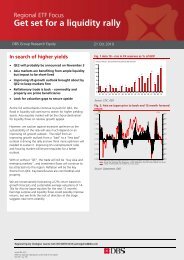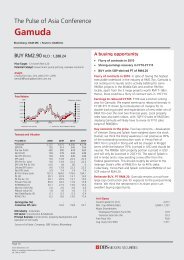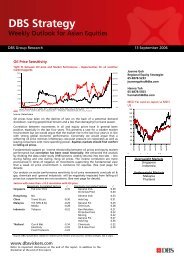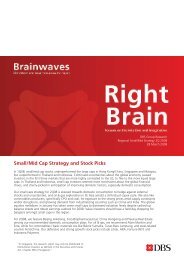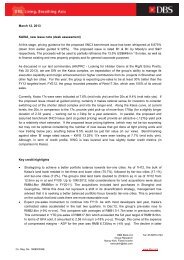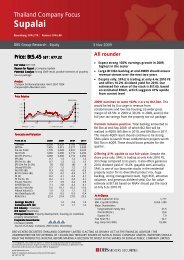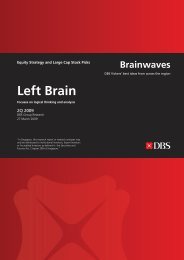Top Down Strategy and Large Cap Stock Picks - the DBS Vickers ...
Top Down Strategy and Large Cap Stock Picks - the DBS Vickers ...
Top Down Strategy and Large Cap Stock Picks - the DBS Vickers ...
Create successful ePaper yourself
Turn your PDF publications into a flip-book with our unique Google optimized e-Paper software.
<strong>Strategy</strong> Overview: Asian Equity<br />
Regional Equity <strong>Strategy</strong> Q4 2007<br />
Markets hit bottom, volatility to last two months<br />
We believe that <strong>the</strong> market volatility related to <strong>the</strong> US sub-prime woes is temporary.<br />
Once <strong>the</strong> dust settles, especially in relation to poor sentiment arising from secondguesses<br />
on how badly banks <strong>and</strong> o<strong>the</strong>r financial institutions are exposed to subprime<br />
mortgages, <strong>the</strong> Asian markets should return to <strong>the</strong>ir upward trajectory.<br />
We expect <strong>the</strong> market to be range bound in <strong>the</strong> next two months as investors grapple<br />
with choppy global markets <strong>and</strong> re-balance portfolios. Timing a market bottom is a<br />
perennial challenge. For all its worth, <strong>the</strong> markets may well have hit bottom during <strong>the</strong><br />
wave of heavy selling on August 17. However, with <strong>the</strong> rebound in prices in recent<br />
weeks, short-term relative strength indicators are currently in neutral territory, <strong>and</strong> do<br />
not point to an imminent reversal. Meanwhile, valuations <strong>and</strong> fundamentals continue<br />
to provide support at current levels; <strong>and</strong> upcoming market events suggest that early<br />
October may be <strong>the</strong> most opportune time for aggressive accumulation. Hence, we<br />
recommend building up positions for a year-end rally, which we believe, will commence<br />
in November.<br />
Vulnerability of <strong>the</strong> US economy<br />
<strong>DBS</strong> Research believes that while <strong>the</strong> worst is over for <strong>the</strong> US economy, <strong>the</strong><br />
expectation is for a weak recovery in <strong>the</strong> US to sub-potential growth rates.<br />
Specifically <strong>the</strong> forecast is for a paltry 2.0% (QoQ, saar) growth in Q3, after 4%<br />
growth in Q2 <strong>and</strong> 0.6% growth in Q1. By Q4 <strong>and</strong> throughout 2008, <strong>the</strong> economy<br />
should grow at a (saar) pace of 2.5%-3%. This view is premised on expectations<br />
for i) weak consumption growth <strong>and</strong> ii) that <strong>the</strong> drag from housing construction<br />
will continue to fade in <strong>the</strong> coming quarters.<br />
In <strong>DBS</strong> view, a recession is not on <strong>the</strong> cards despite growing concerns of <strong>the</strong> US<br />
housing market slump's impact on consumer spending. The US will still be releasing<br />
expectedly poor economic numbers in <strong>the</strong> next three months, in terms of job<br />
growth, consumption <strong>and</strong> housing market expansion, which will induce market<br />
volatility. Commercial paper will remain expensive in <strong>the</strong> short run. However,<br />
<strong>the</strong>se are not enough to drive <strong>the</strong> economy into a recession, but sufficient to<br />
lead <strong>the</strong> Fed to believe that rate cuts are necessary before <strong>the</strong> economy turns for<br />
<strong>the</strong> worse.<br />
If <strong>the</strong> drag from housing does not fade, <strong>the</strong>n GDP growth might continue to<br />
ramble along at about 2%, as it had in <strong>the</strong> past 5 quarters (2.2% for <strong>the</strong> past<br />
seven quarters). While plainly not a plus for Asia, weak US growth in <strong>the</strong> last<br />
two years has not prevented Asia from accelerating modestly <strong>and</strong> ano<strong>the</strong>r year<br />
of expectedly weak 2% growth in <strong>the</strong> US should not make a difference to Asia.<br />
Indeed, <strong>the</strong> bias should be towards a pick up in growth after this soft patch,<br />
considering <strong>the</strong> underlying resilience of <strong>the</strong> US economy over <strong>the</strong> last eight<br />
quarters. Against <strong>the</strong> backdrop of a weak US recovery, investors will remain<br />
focused on domestic dem<strong>and</strong> sectors in Asia, while staying vigilant to an inflection<br />
point for recovery in external dem<strong>and</strong>.<br />
7



